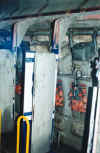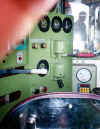Before I start, I must thank the main driving force behind Bangalore expedition, in all the senses, Shri S. Shrinivas. I am also grateful to Shri Rakesh Misra, DRM SBC and Shri Govind Kumar, Sr. DME at KJM.
 Entrance of Krishnarajapuram (KJM) Diesel Loco Shed.
Entrance of Krishnarajapuram (KJM) Diesel Loco Shed.
 Brake simulator helps to identify air and vacuum brake problems.
Brake simulator helps to identify air and vacuum brake problems.
 Locos are tested thoroughly after POH to ensure that diesel power plant and
generator / alternator are in perfect shape.
Locos are tested thoroughly after POH to ensure that diesel power plant and
generator / alternator are in perfect shape.

 Output from generator / rectifier is routed to resistors immersed in water tank
to simulate load.
Output from generator / rectifier is routed to resistors immersed in water tank
to simulate load.
 The voltage and current at various engine speeds is monitored.
The voltage and current at various engine speeds is monitored.
![]() The chart shows expected results.
The chart shows expected results.
 As expected water in tank starts boiling up as load increases.
As expected water in tank starts boiling up as load increases.
![]() Loco washing plant makes KJM diesels shine.
Loco washing plant makes KJM diesels shine.

 Laboratory calibrates all instruments in WDMx family locos. A very spotless lab
I've seen.
Laboratory calibrates all instruments in WDMx family locos. A very spotless lab
I've seen.
 Brand new WDM2c #14077 with smiling S. Srinivas in front. (One of our men at
SBC)
Brand new WDM2c #14077 with smiling S. Srinivas in front. (One of our men at
SBC)
![]() The bogie still shows the original color from DLW, Varanasi.
The bogie still shows the original color from DLW, Varanasi.
 The power plant ready to be overhauled.
The power plant ready to be overhauled.
 Another view of the same loco.
Another view of the same loco.
 Rebuilt and ready to go traction motor.
Rebuilt and ready to go traction motor.
 The dynamic brake grid blower and motor.
The dynamic brake grid blower and motor.
 Area where bogies are reconditioned.
Area where bogies are reconditioned.
 Bogie removed from WDM2 for reconditioning.
Bogie removed from WDM2 for reconditioning.
 Pneumatic reverser valve and circuits.
Pneumatic reverser valve and circuits.
 Traditional controls in WDM2. (Original Alco design).
Traditional controls in WDM2. (Original Alco design).
 Traditional controls with reference to driver's seat.
Traditional controls with reference to driver's seat.
 Compare traditional controls with indigenous desktop controls. There is no
legroom and driver has to bend over the controls. Drivers hate this design. WDP2
has somewhat similar layout.
Compare traditional controls with indigenous desktop controls. There is no
legroom and driver has to bend over the controls. Drivers hate this design. WDP2
has somewhat similar layout.
 This loco does not seem to have MU capability.
This loco does not seem to have MU capability.
|
|
|